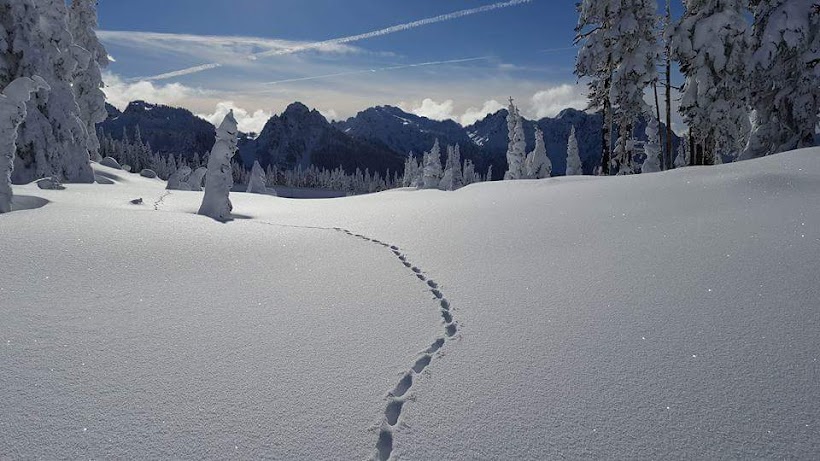Alaska Eagle is a journalistic approach to stories, photographs and video created by author, photographer, journalist ranger and filmmaker John Stoeckl. Some of the posts are being put into his new book project Reflections in the Ice.
Winter

Tracks in the Snow. Photo by John Stoeckl
Wednesday, July 5, 2017
Just another Volcano
“The Only Thing That Is Constant Is Change -” - Heraclitus
Change seems to be the only element that is constant in our world of day to day. Even the slightest change in what would normally be a mundane work week seems to rear its face from time to time. Taking a group on a private tour to Mt. St. Helens, I expected a tremendous change to be prevalent. Sometimes change is huge. Other times its as subtle as a difference in the breeze. Sometimes the subtlest of change can be the biggest difference.
Mt. St. Helens erupted on May 18th, 1980. Since March of that year, it began giving a lot of clues: earthquakes, and small eruptions. On the morning of May 18th, geologist David A. Johnston was out on the northern ridge observing the mountain as he'd done many times before. One big difference is that the mountain had bulged out 450 feet. At 8:26 a.m., the entire north face collapsed in what would be the largest landslide in recorded history. Then the eruption followed spewing upward and northward and blasting and burning everything for miles. It would be the last time David Johnston would be seen again. 56 others would perish as well.
As I drove my group eastward on highway 504 toward the Johnston Ridge Visitor Center, I had expected full recovery. What I saw shocked me. In the act of natural progression, in simple terms, lichens and mosses gather on the exposed bare rock and soil, and make more soil. Pioneering plants will seed and grow on that weak soil and add nutrients to it staging it for the next levels. Shrubs like alders and willows will begin growing. Eventually deciduous trees will sprout, and finally coniferous trees will take over. In Washington state, typically those trees are Douglas firs, western red cedar and western hemlock in the subalpine regions. I had expected these deep green forests and trees to have made a young but fruitful recover over 37 years. What I found was astounding. For at least 14 miles out from the mountain remained mostly barren land. The volcano had literally sterilized the land when the heat and ash blew through at approximately 300 miles per hour stunting the natural progression of regrowth. Most of the rock remained exposed. Bleached logs lay throughout the terrain. Only in the valleys and more distant hillsides were there new signs of life. Alders mostly gathered in the valleys, their rippled leaves apparent. Young forests had regrown only where the land was protected from the blast due to natural geographic layout like cliff sides facing away. New lakes were formed and rivers rerouted. But for a western Washington terrain, it felt like I had landed on a distant planet at some other part of the galaxy.
But although stunted, there was change. No more did one see the rivers of ash, or the mudflows pushing hard down rivers. No more could one see a coned mountain, but a cratered opening. And regrowth was happening. It will be many years before this land returns to the thick green forest known commonly in this region. For us humans, it may be beyond memory. In geologic times, it is merely the blink of the eye.
Subscribe to:
Posts (Atom)

